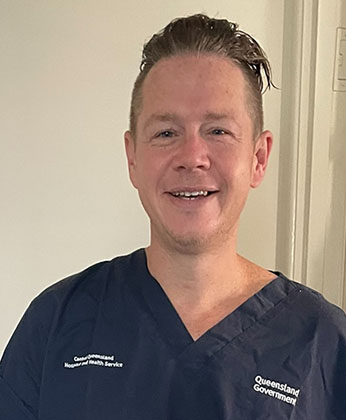If you’ve ever dreamt of being able to provide truly holistic care, reduce a patient’s length of stay, and work more collaboratively with your colleagues – well, maybe you can.
A new feature in Kyra Flow (also known as Patient Flow Manager) allows you drill down to a patient’s specific needs, rationalise clinical decision making, and discharge patients sooner – all with a few simple clicks. And according to Rockhampton Hospital Nursing Director James Jenkins, it’s a breath of fresh air.
“We started using the Discharge Delay Tab (DDT) in its earliest form about 18 months ago as part of our multidisciplinary team ward rounds. We moved away from setting an estimated date of discharge.”
“Now we narrow it down to exactly what needs to happen for this patient so they can go home.”
James said using DDT as part of multidisciplinary rounds in their medical ward had boosted working relationships, because when completing the information staff needed to drill down to specific patient needs.
“It’s a true MDT. You get to ask very specific questions – what exactly do they need, why, who needs to do it and by when – things you wouldn’t ordinarily get to discuss or feel empowered to ask.”
“As nurses, we spend a lot of time chasing things that the patient doesn’t even need. With DDT, you get to be prescriptive about what the patient actually needs. Your lens moves from completing a list of things you think you need to do, to purposeful tasks that will contribute to that patient going home or onto the next step in their care journey,” James said.
For James, the real benefit of DDT was being able to connect more with what it meant to be a nurse.
“It’s holistic patient care because you know an individual requires X-Y-Z and you get it to them in a timely manner. More of your time is then spent caring for that person and you’re utilising your purpose as a healthcare provider,” he said.
Beyond saving time, being more efficient and building more collegiate relationships, James said the DDT has obvious patient benefits as well.
“Being discharged earlier means there is reduced risk of the patient deconditioning, reduce risk of hospital-acquired infections, complications or falls, which means we are keeping them out of harm.”
“For Rockhampton, the DDT has changed our focus to ensuring what we do benefits the patient when they leave hospital. Care that adds value to their life.”
But the proof is in the pudding. What does the data say? According to recent data from Health Roundtable, Rockhampton and Gladstone had the lowest medical length of stay and highest discharges per day rate in Queensland.
“With more discharges per day you get better flow because you create capacity sooner, and for a Nurse Unit Manager you can get back to doing your job and not spending time trying to create space.”
James said Rockhampton had also uncovered a range of other unexpected benefits after using the Discharge Delay Tab.
“We have found the DDT requires us to engage with community providers a lot earlier in the game which helps ensure the patient has a planned and coordinated discharge, but also better integrates them with community service providers.”
“Community services identify things a patient might need that inpatient staff might not know or realise.”
“DDT enables allied health time to be used more efficiently too, which means they have more time with patients who really need them, so those patients get better outcomes too.”
“It’s very simple, but it opens up a whole platform to let you care for a human being.”
To find out more about the Discharge Delay Tab, search ‘Patient Flow CEQ’ on QHEPS.

James Jenkins is currently Acting Director of Nursing for Practice Innovation in the Office of the Chief Nursing and Midwifery Officer, a branch within Clinical Excellence Queensland.